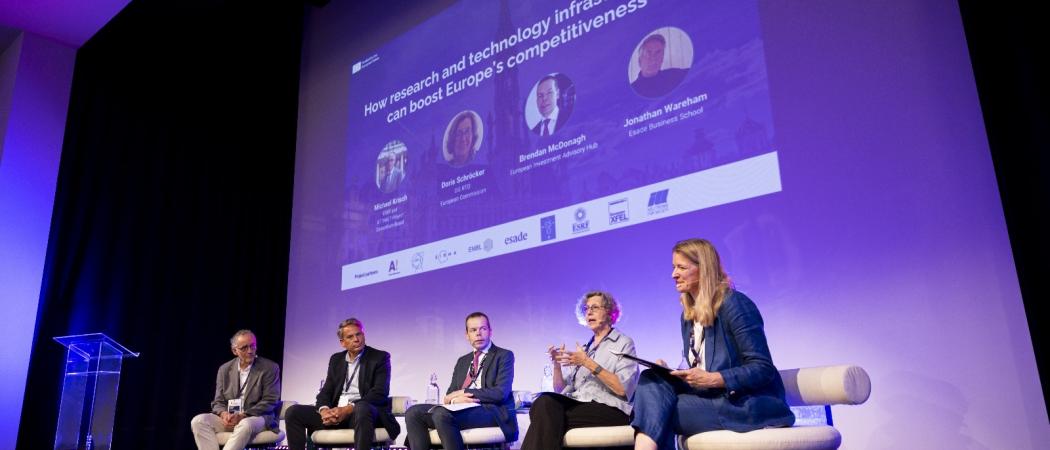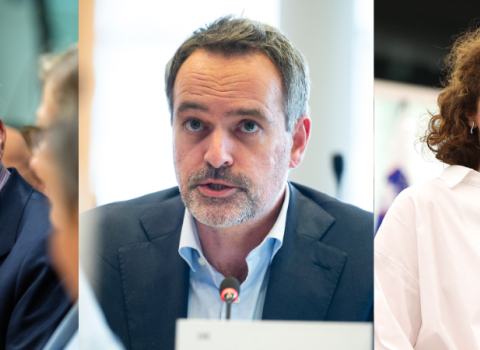ATTRACT highlights the potential of research infrastructures to boost Europe’s competitiveness and security

ATTRACT Final Conference. From the left: Michael Krisch, director of research at the European Synchrotron Radiation Facility and Chair of the ATTRACT Consortium Board; Jonathan Wareham, professor at the Esade Business School; Brendan McDonagh, senior adviser, European Investment Bank - Advisory; Doris Schröcker, head of unit for Industrial Research, Innovation and Investment Agendas at the European Commission’s DG RTD; Maryline Fiaschi, CEO, Science|Business. Photo credits: ATTRACT
Can Europe’s leading research infrastructures become a commercial springboard for deep tech startups?
At ATTRACT’s final conference in early July, Doris Schröcker, head of unit for Industrial Research, Innovation and Investment Agendas at the European Commission’s DG RTD, hinted at a bigger future role for Europe’s research infrastructures in EU funding policies. So-called deep tech infrastructures, such as CERN, which focus on scientific breakthroughs, can help increase Europe’s competitiveness and its security, she said. Along with CERN, ATTRACT was led by a consortium of big research institutions, universities, and the European Industrial Research Management Association, and was funded by the EU Horizon 2020 programme.
In the same plenary panel at the conference, Michael Krisch, director of research at the European Synchrotron Radiation Facility and Chair of the ATTRACT Consortium Board, said project participants were “ready for the next step” – whatever that might be.
The European Commission is still finalising its plans for a successor to its current Horizon Europe programme. Schröcker declined to provide any details of the Commission’s plans but said they would emphasise measures intended to increase European competitiveness and security.
The panellists agreed that ATTRACT had done a good job of providing a source of sustainable financing to the entrepreneurs it funded over the course of the project, which began in 2018. Among the projects ATTRACT funded were a jacket that can collect drinkable water from thin air (a concept popularised by the sci-fi novel Dune), novel wearable health monitoring devices and a startup, Random Power, that harnesses CERN-inspired unpredictable quantum signals to thwart hackers.
But Brendan McDonagh, a senior adviser with the European Investment Bank’s Advisory Hub, said there is still a need to put greater emphasis on the eventual commercialisation of promising research as opposed to non-commercial scientific research. “Europe needs to maximise the return on investment on research infrastructure,” he told the conference. “The private sector will get involved when they see the potential returns.” The EIB also cannot give a loan without being able to foresee a revenue stream, McDonagh added.
Drawing on his experience with the ATTRACT project, Jonathan Wareham, a professor at the Esade Business School, called for business schools to do a better job of helping aspiring entrepreneurs touch and feel actual tech rather than just being told about it or watching a video about it. “Are our graduates equipped to be deep tech entrepreneurs? No,” he said, adding that ATTRACT had provided invaluable experience to the students who participated in the programme.
Involving the private sector from the very beginning
Several experts stressed the importance of involving potential private-sector business partners from the start - and throughout – entrepreneurial projects’ R&D journeys, both for the real-world insights they can share, but also as potential customers. “The best thing you can do for an entrepreneur is to buy the products,” and that’s easier to do if you have already helped develop them, said Wareham.
Each project funded by ATTRACT needed to have a commercial partner from the very beginning, but speakers stressed the importance of keeping the business partners’ interest over the course of several years, as a project evolves towards higher levels of technology readiness.
The EIB found it hard to become more actively involved in the ATTRACT project because of the differences in its and ATTRACT’s funding models. “It’s difficult to mix grant and credit funding,” said McDonagh.
Building a community of shared values
Several participants stressed the intangible value of the ecosystem that the ATTRACT project helped create by bring together people from academia, research institutes and commercial partners across Europe and introducing them to the resources that Europe’s research infrastructures offer.
Victor Negrescu, a vice president of the European Parliament involved in helping shape EU research policies, said some people don’t immediately see the link between research and innovation and competitiveness, because they only see the money that goes into research programmes and not their full impact. “What’s the multiplication effect of the different projects?” he asked rhetorically. “Research and innovation is not only about discovery, but also about creating a community of shared values.”
Negrescu cited recent reports by former Italian Prime Ministers Enrico Letta and Mario Draghi, which emphasised the role that research infrastructures, such as CERN, and supercomputing facilities could play in helping to incubate “deep tech” entrepreneurial ventures and thereby help Europe improve its competitiveness on the world stage.
In the wake of the Draghi report, Negrescu said he had helped fend off proposed cuts to EU research and development spending, while advocating increasing the EU research budget by an additional €400 million.





 A unique international forum for public research organisations and companies to connect their external engagement with strategic interests around their R&D system.
A unique international forum for public research organisations and companies to connect their external engagement with strategic interests around their R&D system.